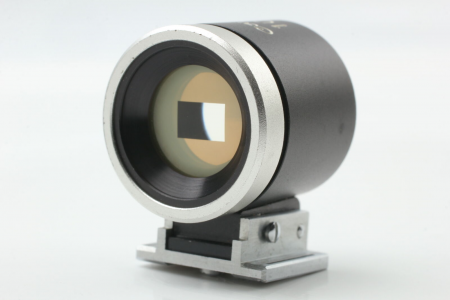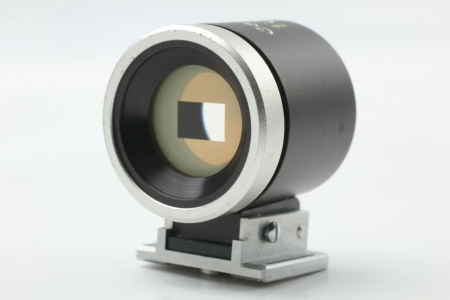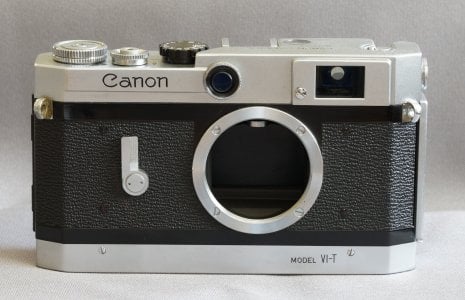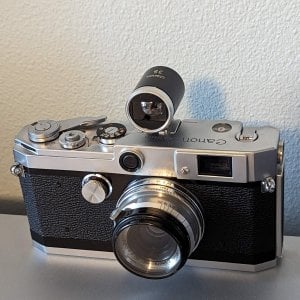Jason Schneider
the Camera Collector
The incredible V-, VI-series Canon rangefinder 35s:
How Canon crushed Leica with the coolest accessory viewfinder system ever!
By Jason Schneider
The great Leica vs. Nikon vs. Canon rangefinder battle of the ‘50s still reverberates with a lot of passion, along with a momentous amount of malarkey. Nobody disputes the fact that both Nikon and Canon emerged from the ashes of World War II fiercely determined to create high quality 35mm rangefinder cameras to challenge the Leica and Zeiss Contax on the world market. Favorable reviews by Life Magazine photographers gave Nikon cameras and Nikkor lenses an early boost, and Canon followed up with the landmark Canon IIB, sporting an ingenious 3-magnification range/viewfinder, which evolved into the hugely successful Canon IVSB introduced in 1952. Then, at Photokina 1954, Leica lowered the boom, shocking the camera world by bringing forth the groundbreaking Leica M3, with a multi-frame parallax-compensating viewfinder, an M bayonet lens mount, a film wind lever, a hinged back, and much more. The engineers at Nikon and Canon were stunned, but to their credit, within 2 years both companies came out with new models designed to compete with the Wetzlar Wunderkind and its successors. Both Nikon and Canon steadily developed their elite rangefinder 35s eventually coming out with models including the Nikon SP of 1957-1960, the Canon 7 (1961-1964) and Canon 7s (1965-1967), all of which had muti-frame camera viewfinders with true projected parallax compensating frame lines that rivaled the Leica M4’s.
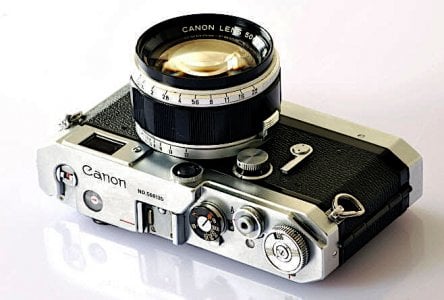
Canon VT Deluxe (VTD) showing parallax-compensating pin in accessory shoe that tilted accessory viewfinders as you focused. Brilliant!
For all their conceptual brilliance, technological audacity, and exquisite craftsmanship, no Nikon or Canon rangefinder camera ever equaled the Leica M in terms of its seamlessly integrated functionality, mainly because neither one ever had a modern (fixed, wide diameter) bayonet lens mount. Nikon wisely ditched the complex less reliable vertical roller blind shutter used in the Contax and employed a Leica-style horizontal-travel focal plane shutter (mostly silk cloth, later titanium foil) in all their S-series rangefinder cameras. However, they stuck with a Contax-derived bayonet lens mount, which relies on a focusing helical built into the body. Canon famously soldiered on with the 39mm LTM screw mount, the same one used on all II- and III-series Leicas from 1931 to 1960, eventually adding a supplementary external bayonet to stabilize long teles. As a result, no Nikon or Canon rangefinder camera ever provided auto-indexing frame lines that come into view as you mount a lens. And obviously only the Leica M has a front-mounted spring-loaded frame line preview lever, a convenience lacking on the Nikon or Canin, which require that you turn a ring to change viewfinder frame lines.
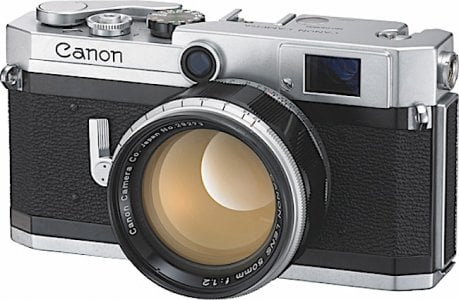
The apotheosis of rangefinder Canon's? Many consider this lever wind Canon VI-L with projected parallax-compensating viewfinder frame lines the best of the breed. Canon's superb VI series was the last to include Canon's ingenious parallax-compensating accessory viewfinder system.
The Leica M cameras also score on their super bright, crisply defined rectangular rangefinder patches, which allow you to use the more accurate split-image focusing technique, especially with subjects having distinct vertical lines. Canon mostly used the classic round rangefinder patch, switching to rectangular in the 7-series, and Nikon used a rectangular patch ( \square in earlier models like the Nikon S), but in neither case was the focusing patch as crisply delineated as the one in M-series Leicas. Another plus point for the Leica M is its sleek rounded-ends form factor which Leica aficionados toout as more ergonomic and hand-holdable. I concede that the Leica’s rounded form is esthetically pleasing, but I have never had a problem comfortable hand-holding my vintage rangefinder Canons or Nikons, though I’ve never been a fan of the Nikon’s milled wheel focusing system inherited from the Contax.
Nikon took up the challenge posed by the Leica M3 by bringing forth the Nikon S2 in record time –it was announced in December 1954 and over 56,000 were produced by the end of production in June, 1958, making it the highest production Nikon S-series camera ever. It had a bigger, brighter life size (1.0x) range/viewfinder with a fixed reflected 50mm bright frame line, a single stroke lever wind and folding crank rewind, a standard PC sync terminal with X sync, shutter speeds upped to 1-1/000 sec plus B and T, a totally revised, upgraded shutter mechanism, and, glory be, a standard 24 x 36mm format (its predecessor the Nikon S was 24 x 34mm!). The Nikon S2 is a timeless minimalist classic, a shooter’s delight, and my personal favorite rangefinder Nikon, but it is technically and functionally not in the same league as the mighty Leica M3.
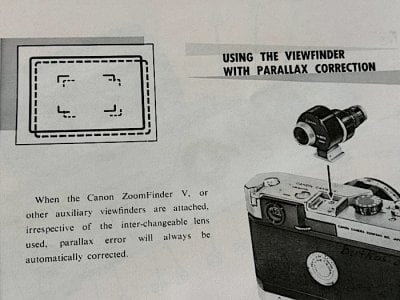
Page from Canon VT Deluxe (VTD) manual showing how to the use shoe-based parallax compensation system with an accessory Zoomfinder.
Canon‘s initial “response” to the Leica M3 was, ironically, easing into production just as the Leica M3 was announced. The Canon IVSB2, unveiled in July 1954 and produced until July 1956, was, in the words of Canon guru Peter Dechert, “surely… the finest bottom- loading 35mm rangefinder camera anyone has ever built.” It had an improved shutter mechanism with slow speed dial split at 1/30 sec, modern geometric speed sequence (a feature not available on the original M3!), speeds to 1/1000 sec with X sync at about 1/45 sec, and provision for setting fast speeds with the shutter cocked or un-cocked. It also featured a larger eyepiece for Canon’s signature 3-mode finder, and provision for fitting a rapid wind baseplate. It took another year for Canon to offer the Canon VT, its first real competitor to the all-conquering Leica M3, and it incorporated one ingenious feature Leica never equaled.
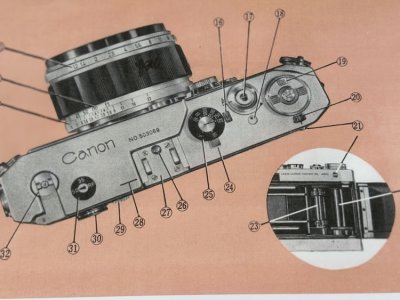
Illustration from the Canon VT Deluxe (VTD) manual showing camera components. Parallax-adjusting pin in shoe is callout number 26.
The landmark Canon VT of April 1956 to February 1957 sure looks like a revolutionary design, but it’s essentially a Canon IVS2B with an enlarged, upgraded version of Canon’s signature 3-mode finder, a PC outlet in place if the funky side flash rail, a hinged back for easier loading, and a trigger wind baseplate. The click-stopped viewfinder lever can be set to provide a minified view or the 35mm field, a 0.7x view of the 50mm field, or a 150% view if the rangefinder for more accurate focusing. No bright frames or parallax correction were built in, but Canon devised a devilishly clever alternative that nether Leica nor Nikon ever offered, namely a small domed pin at the front of the accessory shoe that rises and falls as the lens is focused, thereby tilting any mounted Canon V-type accessory viewfinder to provide automatic parallax compensation. Wow! This automatic parallax-correcting viewfinder pin coupling remained a standard feature in all subsequent Canon rangefinder cameras, including the Canon L1, L2, VT DELUXE, DELUXE VTDZ, and VTDM, Canon VL and VL2, Canon VI-L and VI-T. It was deleted on the broad-spectrum Canon P (which had fixed reflected frame lines for 35mm, 50mm, and 100mm lenses) and the Canon 7, 7s, and 7sZ, all of which had user-selected projected parallax-compensating frame lines for 35mm, 50mm, 85/100 mm and 135mm focal lengths.
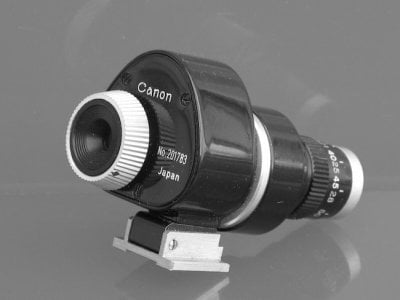
Canon Universal Zoomfinder S for 35-50mm lenses. An adapter (not shown) allows it to work with 21-28mm lenses.
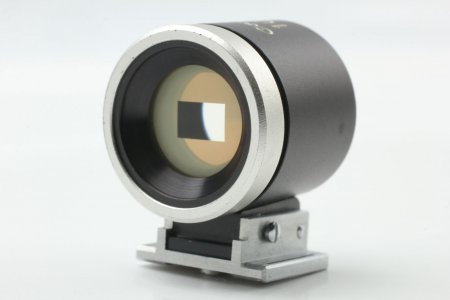
Canon Lumi-Field 100mm viewfinder had reflected bright line frame. These were produced in final lengths from 50mm to 135mm.
Canon offered an incredible range of shoe-mount accessory viewfinders for Canon rangefinder cameras—more than Nikon or even Leica. Single focal length versions from 21mm to 135mm with the right linkage for auto parallax compensation are generally available. Those with built in parallax adjusters, or predating Canon’s parallax compensating hot shoe can usually be made work with Canon’s tilting hot shoe when set to infinity. Canon also offered a variety of zoom finders covering lenses from 35-135mm, multi-lens shoe-mount turret-type viewfinders covering lenses from 35-135mm, and a remarkable Twin Turret Varifocal Viewfinder that covers focal lengths from 21mm to 135mm!
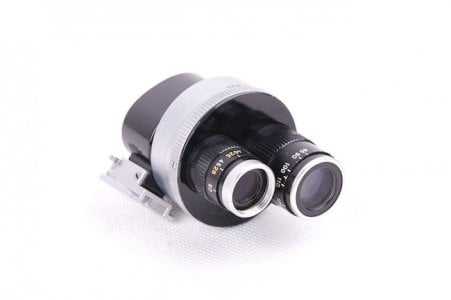
Canon's ingeniousd Twin-Turret Varifocal Viewfinder covers focal lengths from 21-135mm!
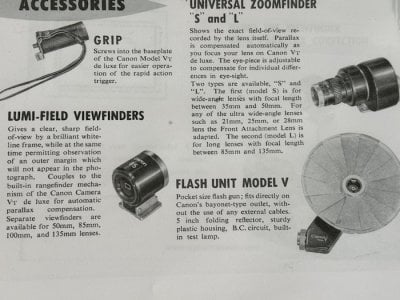
Accessories page from Canon VT Deluxe (VTD) manual shows Universal Zoom Finder that was available in S (short focal length range) and L (long focal length range) versions and individual Lumi-Field viewfinders that came in 50mm, 85mm, 100mm, and 135mm focal lengths
All provide auto parallax compensation with the previously mentioned shoe-mount finders when mounted on the crowning glory of Canon’s rangefinder cameras, those beginning with the Canon VT and concluding with the glorious Canon VI-T and VI-L both of which had top-mounted single shutter speed dials and bright parallax-compensating projected finder frame lines for 50mm and 100mm lenses. Incidentally, Canon also made a series of black viewfinders with the necessary linkage in 25, 28, 35, 50, 85, 100, and 135 focal lengths. The 50 and longer focal lengths had bright line frames. There were also two universal zoom finders, one for wide angles, the other for telephotos. While using any auxiliary viewfinder mean that viewing and focusing become separate operations, many photographers prefer the quality of the view through separate finders, which is often a tad brighter and clearer than what you see through the camera’s built-in finder. The choice is yours, but one thing is crystal clear: Canon’s brilliant automatic parallax-compensating, shoe-mount auxiliary finder system is the best one ever offered on any 35mm rangefinder camera..
How Canon crushed Leica with the coolest accessory viewfinder system ever!
By Jason Schneider
The great Leica vs. Nikon vs. Canon rangefinder battle of the ‘50s still reverberates with a lot of passion, along with a momentous amount of malarkey. Nobody disputes the fact that both Nikon and Canon emerged from the ashes of World War II fiercely determined to create high quality 35mm rangefinder cameras to challenge the Leica and Zeiss Contax on the world market. Favorable reviews by Life Magazine photographers gave Nikon cameras and Nikkor lenses an early boost, and Canon followed up with the landmark Canon IIB, sporting an ingenious 3-magnification range/viewfinder, which evolved into the hugely successful Canon IVSB introduced in 1952. Then, at Photokina 1954, Leica lowered the boom, shocking the camera world by bringing forth the groundbreaking Leica M3, with a multi-frame parallax-compensating viewfinder, an M bayonet lens mount, a film wind lever, a hinged back, and much more. The engineers at Nikon and Canon were stunned, but to their credit, within 2 years both companies came out with new models designed to compete with the Wetzlar Wunderkind and its successors. Both Nikon and Canon steadily developed their elite rangefinder 35s eventually coming out with models including the Nikon SP of 1957-1960, the Canon 7 (1961-1964) and Canon 7s (1965-1967), all of which had muti-frame camera viewfinders with true projected parallax compensating frame lines that rivaled the Leica M4’s.

Canon VT Deluxe (VTD) showing parallax-compensating pin in accessory shoe that tilted accessory viewfinders as you focused. Brilliant!
For all their conceptual brilliance, technological audacity, and exquisite craftsmanship, no Nikon or Canon rangefinder camera ever equaled the Leica M in terms of its seamlessly integrated functionality, mainly because neither one ever had a modern (fixed, wide diameter) bayonet lens mount. Nikon wisely ditched the complex less reliable vertical roller blind shutter used in the Contax and employed a Leica-style horizontal-travel focal plane shutter (mostly silk cloth, later titanium foil) in all their S-series rangefinder cameras. However, they stuck with a Contax-derived bayonet lens mount, which relies on a focusing helical built into the body. Canon famously soldiered on with the 39mm LTM screw mount, the same one used on all II- and III-series Leicas from 1931 to 1960, eventually adding a supplementary external bayonet to stabilize long teles. As a result, no Nikon or Canon rangefinder camera ever provided auto-indexing frame lines that come into view as you mount a lens. And obviously only the Leica M has a front-mounted spring-loaded frame line preview lever, a convenience lacking on the Nikon or Canin, which require that you turn a ring to change viewfinder frame lines.

The apotheosis of rangefinder Canon's? Many consider this lever wind Canon VI-L with projected parallax-compensating viewfinder frame lines the best of the breed. Canon's superb VI series was the last to include Canon's ingenious parallax-compensating accessory viewfinder system.
The Leica M cameras also score on their super bright, crisply defined rectangular rangefinder patches, which allow you to use the more accurate split-image focusing technique, especially with subjects having distinct vertical lines. Canon mostly used the classic round rangefinder patch, switching to rectangular in the 7-series, and Nikon used a rectangular patch ( \square in earlier models like the Nikon S), but in neither case was the focusing patch as crisply delineated as the one in M-series Leicas. Another plus point for the Leica M is its sleek rounded-ends form factor which Leica aficionados toout as more ergonomic and hand-holdable. I concede that the Leica’s rounded form is esthetically pleasing, but I have never had a problem comfortable hand-holding my vintage rangefinder Canons or Nikons, though I’ve never been a fan of the Nikon’s milled wheel focusing system inherited from the Contax.
Nikon took up the challenge posed by the Leica M3 by bringing forth the Nikon S2 in record time –it was announced in December 1954 and over 56,000 were produced by the end of production in June, 1958, making it the highest production Nikon S-series camera ever. It had a bigger, brighter life size (1.0x) range/viewfinder with a fixed reflected 50mm bright frame line, a single stroke lever wind and folding crank rewind, a standard PC sync terminal with X sync, shutter speeds upped to 1-1/000 sec plus B and T, a totally revised, upgraded shutter mechanism, and, glory be, a standard 24 x 36mm format (its predecessor the Nikon S was 24 x 34mm!). The Nikon S2 is a timeless minimalist classic, a shooter’s delight, and my personal favorite rangefinder Nikon, but it is technically and functionally not in the same league as the mighty Leica M3.

Page from Canon VT Deluxe (VTD) manual showing how to the use shoe-based parallax compensation system with an accessory Zoomfinder.
Canon‘s initial “response” to the Leica M3 was, ironically, easing into production just as the Leica M3 was announced. The Canon IVSB2, unveiled in July 1954 and produced until July 1956, was, in the words of Canon guru Peter Dechert, “surely… the finest bottom- loading 35mm rangefinder camera anyone has ever built.” It had an improved shutter mechanism with slow speed dial split at 1/30 sec, modern geometric speed sequence (a feature not available on the original M3!), speeds to 1/1000 sec with X sync at about 1/45 sec, and provision for setting fast speeds with the shutter cocked or un-cocked. It also featured a larger eyepiece for Canon’s signature 3-mode finder, and provision for fitting a rapid wind baseplate. It took another year for Canon to offer the Canon VT, its first real competitor to the all-conquering Leica M3, and it incorporated one ingenious feature Leica never equaled.

Illustration from the Canon VT Deluxe (VTD) manual showing camera components. Parallax-adjusting pin in shoe is callout number 26.
The landmark Canon VT of April 1956 to February 1957 sure looks like a revolutionary design, but it’s essentially a Canon IVS2B with an enlarged, upgraded version of Canon’s signature 3-mode finder, a PC outlet in place if the funky side flash rail, a hinged back for easier loading, and a trigger wind baseplate. The click-stopped viewfinder lever can be set to provide a minified view or the 35mm field, a 0.7x view of the 50mm field, or a 150% view if the rangefinder for more accurate focusing. No bright frames or parallax correction were built in, but Canon devised a devilishly clever alternative that nether Leica nor Nikon ever offered, namely a small domed pin at the front of the accessory shoe that rises and falls as the lens is focused, thereby tilting any mounted Canon V-type accessory viewfinder to provide automatic parallax compensation. Wow! This automatic parallax-correcting viewfinder pin coupling remained a standard feature in all subsequent Canon rangefinder cameras, including the Canon L1, L2, VT DELUXE, DELUXE VTDZ, and VTDM, Canon VL and VL2, Canon VI-L and VI-T. It was deleted on the broad-spectrum Canon P (which had fixed reflected frame lines for 35mm, 50mm, and 100mm lenses) and the Canon 7, 7s, and 7sZ, all of which had user-selected projected parallax-compensating frame lines for 35mm, 50mm, 85/100 mm and 135mm focal lengths.

Canon Universal Zoomfinder S for 35-50mm lenses. An adapter (not shown) allows it to work with 21-28mm lenses.

Canon Lumi-Field 100mm viewfinder had reflected bright line frame. These were produced in final lengths from 50mm to 135mm.
Canon offered an incredible range of shoe-mount accessory viewfinders for Canon rangefinder cameras—more than Nikon or even Leica. Single focal length versions from 21mm to 135mm with the right linkage for auto parallax compensation are generally available. Those with built in parallax adjusters, or predating Canon’s parallax compensating hot shoe can usually be made work with Canon’s tilting hot shoe when set to infinity. Canon also offered a variety of zoom finders covering lenses from 35-135mm, multi-lens shoe-mount turret-type viewfinders covering lenses from 35-135mm, and a remarkable Twin Turret Varifocal Viewfinder that covers focal lengths from 21mm to 135mm!

Canon's ingeniousd Twin-Turret Varifocal Viewfinder covers focal lengths from 21-135mm!

Accessories page from Canon VT Deluxe (VTD) manual shows Universal Zoom Finder that was available in S (short focal length range) and L (long focal length range) versions and individual Lumi-Field viewfinders that came in 50mm, 85mm, 100mm, and 135mm focal lengths
All provide auto parallax compensation with the previously mentioned shoe-mount finders when mounted on the crowning glory of Canon’s rangefinder cameras, those beginning with the Canon VT and concluding with the glorious Canon VI-T and VI-L both of which had top-mounted single shutter speed dials and bright parallax-compensating projected finder frame lines for 50mm and 100mm lenses. Incidentally, Canon also made a series of black viewfinders with the necessary linkage in 25, 28, 35, 50, 85, 100, and 135 focal lengths. The 50 and longer focal lengths had bright line frames. There were also two universal zoom finders, one for wide angles, the other for telephotos. While using any auxiliary viewfinder mean that viewing and focusing become separate operations, many photographers prefer the quality of the view through separate finders, which is often a tad brighter and clearer than what you see through the camera’s built-in finder. The choice is yours, but one thing is crystal clear: Canon’s brilliant automatic parallax-compensating, shoe-mount auxiliary finder system is the best one ever offered on any 35mm rangefinder camera..
Attachments
Last edited:
AlwaysOnAuto
Well-known
Gregm61
Well-known
And that's a nice one.
One of those "wish I never sold it" outfits years later was a VT deLux and 35mm f1.8 screw mount Nikkor.
One of those "wish I never sold it" outfits years later was a VT deLux and 35mm f1.8 screw mount Nikkor.
wes loder
Photographer/Historian
Never cared for the Canon finders. As for the wide angle zoom finder. 35-50? Why bother with such a limited range? The parallax compensating pin? That's fine IF you are using a Canon finder, but of little use for a shoe-mounted flash or non-Canon finder. Of course, one could always mount a Canon flash on the side receptacle, but that only worked with Canon flashguns. Canon was certainly innovative, but a lot of its innovations—like the trigger advance—were ideas that only appealed to a select few.
scholzj1
Member
ranger9
Well-known
35 and 50 were (and are) widely-used focal lengths on 35mm RF cameras, so combining them let the photographer switch quickly without having to change (or carry) separate finders. As to “that's fine IF you are using a Canon finder”… uh, that was probably the whole point, dontcha think? Getting people who used accessory finders to use the Canon ones?As for the wide angle zoom finder. 35-50? Why bother with such a limited range? The parallax compensating pin? That's fine IF you are using a Canon finder…
ranger9
Well-known
This is a fascinating read, although I admit I'm biased via owning a VI-T plus the 85mm Canon finder I tracked down to use with my 85mm lens.
Still, there's no denying that a combined range/viewfinder with multiple projected frames was a better solution… which is why it was so smart of Steinheil to introduce them on the Casca II, and so stinky of certain well-connected bullies in Wetzlar to quash it…
Still, there's no denying that a combined range/viewfinder with multiple projected frames was a better solution… which is why it was so smart of Steinheil to introduce them on the Casca II, and so stinky of certain well-connected bullies in Wetzlar to quash it…
wlewisiii
Just another hotel clerk
Never had one of the models that had the parallax pin in the shoe. Went from a IVsb to a 7 (and still get tempted by a P even with my beautiful Nikon S2 in hand  ).
).
The zoom finder I just stumbled on for Nikon has shown me how cool those can be so I'm willing to bet Canon did as good a job with theirs as well. Much better than my experiences with turret finders.
The zoom finder I just stumbled on for Nikon has shown me how cool those can be so I'm willing to bet Canon did as good a job with theirs as well. Much better than my experiences with turret finders.
Trask
Established
I fully agree it's an elegant solution to parallax adjustment. I had to learn the hard way not to use a non-Canon pin-drive viewfinder on my Canon L-1, for the camera internals will want to drive the pin up even when there's no "give" in a non-Canon finder. The pin can be bent down inside the camera, throwing off correct framing with a Canon finder. Ask me how I know...lucky for me, DAG knows how to fix my errors.
And Jason - thanks for your never-ending series of interesting and instructive articles!
And Jason - thanks for your never-ending series of interesting and instructive articles!
The Spastic Image
Established
My L1 is such a joy to use and a pleasure. I love the built in VF/RF for 35 mm/50 mm lenses. It is one of the nicest LTM cameras to use as a shooter. Smooth, and pleasant, and makes nice images.I've always enjoyed using the parallax correcting viewfinder on my L1. View attachment 4828274
pixie79
Member
Yet! With all that, the Leica M3 outsold Canon, Nikon.
Maybe bayonet mount, better, clearer Rangefinder, whatever!
Maybe bayonet mount, better, clearer Rangefinder, whatever!
Jason Schneider
the Camera Collector
Thanks very much for your kind words. Ouch! I never bent the parallax-adjusting pin on any of my six (count 'em) V-, VI, and L-series Canons, but thanks for the warning. I always use a compatible Canon accessory viewfinder, all of which are excellent.I fully agree it's an elegant solution to parallax adjustment. I had to learn the hard way not to use a non-Canon pin-drive viewfinder on my Canon L-1, for the camera internals will want to drive the pin up even when there's no "give" in a non-Canon finder. The pin can be bent down inside the camera, throwing off correct framing with a Canon finder. Ask me how I know...lucky for me, DAG knows how to fix my errors.
And Jason - thanks for your never-ending series of interesting and instructive articles!
Mackinaw
Think Different
Thank you Jason, for another fine read. The clever Canon viewfinders are the main reason why I use Canon rangefinders. I have the 25mm 50mm, and 100mm finders that I use on my L1 and VI-T (the 50 and 100 being bright line finders). The auto-parallax pin is absolutely ingenious and works perfectly. This must have been quite the sensation when it was introduced.
Jim B.
Jim B.
Thankyou Jason, a great read. Can get expensive....
I have the 135mm finder, and the Canon V-t deluxe.
The finder came in the cool plastic bubble case. Makes it easy to find the right focal length.
I have the 135mm finder, and the Canon V-t deluxe.
The finder came in the cool plastic bubble case. Makes it easy to find the right focal length.
BillBingham2
Registered User
When I was looking for different external finders some years back I remember seeing a shoe adapter that Canon made that allowed you to adjust the distance for those of us who didn't have the right magical Canon body.
As always Jason, way cool info, wonderful stuff.
B2 (;->
As always Jason, way cool info, wonderful stuff.
B2 (;->
The Spastic Image
Established
Canon sold more 7 Leica Screw Mount RF cameras than any single model of Leica M camera (even the M3). And I am not knocking no M3 or M2 (my dream RF cameras). The Canon P sold more cameras than all Nikon RF cameras combined.Yet! With all that, the Leica M3 outsold Canon, Nikon.
Maybe bayonet mount, better, clearer Rangefinder, whatever!
ranger9
Well-known
Plus longer production life (1954-1966!), better-established brand name, and snob appeal. The M3 sold 220,000 units during its lifetime, while 7-series Canons sold 157,000 units during their 1961-66 production life... or 71% of the M3's volume in only 42% of the time. So, once Canon came back, they came back in a big way! Of course this is after the period discussed in JS's article, but the IV/V/VI cameras certainly played a big role in establishing the brand, even if they weren't big-volume sellers...Yet! With all that, the Leica M3 outsold Canon, Nikon.
Maybe bayonet mount, better, clearer Rangefinder, whatever!
Bingley
Mentor
Jason, Thank you for starting this thread and for your posts. Your comments on Canon’s approach to parallax compensation have got me thinking… I’ve got a Canon IVSB2 and a VI-L, and a 85mm auxiliary Canon vf. I like the 85mm focal length for landscape photography, for example when I want to isolate a subject. But the Canon 85mm lenses are v. large and heavy (I have the 85mm f1.9; it weighs a ton). The Nikkor 85mm f.2 lenses, while not exactly compact and light, are still smaller and (I find) easier to handle than the Canon 85mm lenses. I also happen to own a Nikkor 85mm f2.0 in Contax rangefinder mount; as well as one of the newly re-released Amedeo Contax to LTM adapters. Mounting the 85mm Nikkor w/ the Amedeo adapter on a Canon VI-L, and using the 85mm Canon auxiliary vf, should work together and eliminate any parallax issues, right? I don’t see anything to indicate that the external VFs by Canon only work with Canon lenses….
aw614
Established
I don't think it requires Canon lenses, on my L1/L2 regardless of the lens that is mounted, you can see that little ball that couples with the aux viewfinder move.Jason, Thank you for starting this thread and for your posts. Your comments on Canon’s approach to parallax compensation have got me thinking… I’ve got a Canon IVSB2 and a VI-L, and a 85mm auxiliary Canon vf. I like the 85mm focal length for landscape photography, for example when I want to isolate a subject. But the Canon 85mm lenses are v. large and heavy (I have the 85mm f1.9; it weighs a ton). The Nikkor 85mm f.2 lenses, while not exactly compact and light, are still smaller and (I find) easier to handle than the Canon 85mm lenses. I also happen to own a Nikkor 85mm f2.0 in Contax rangefinder mount; as well as one of the newly re-released Amedeo Contax to LTM adapters. Mounting the 85mm Nikkor w/ the Amedeo adapter on a Canon VI-L, and using the 85mm Canon auxiliary vf, should work together and eliminate any parallax issues, right? I don’t see anything to indicate that the external VFs by Canon only work with Canon lenses….
dexdog
Mentor
You should get a Canon 85/1.8 (my favorite lens in this focal length, even more than the 85/2 Sonnar). It weighs 470 grams, as compared to the chrome 85/1.9 that weighs 565 to 604 grams depending on the version according to Peter K's book. I just weighed my Nikkor 85/2 for Contax, it is 496 grams. I have the Canon 85/1.9 and agree that it is a heavy beast!I like the 85mm focal length for landscape photography, for example when I want to isolate a subject. But the Canon 85mm lenses are v. large and heavy (I have the 85mm f1.9; it weighs a ton). The Nikkor 85mm f.2 lenses, while not exactly compact and light, are still smaller and (I find) easier to handle than the Canon 85mm lenses.
Share:
-
This site uses cookies to help personalise content, tailor your experience and to keep you logged in if you register.
By continuing to use this site, you are consenting to our use of cookies.


